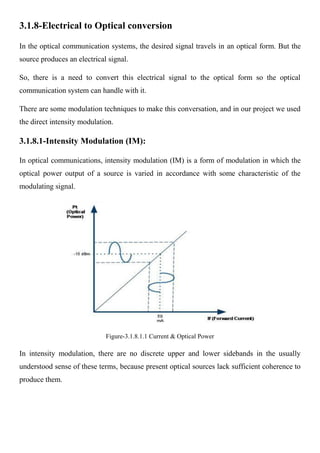
Electrical to optical conversion final
- 1. 3.1.8-Electrical to Optical conversion In the optical communication systems, the desired signal travels in an optical form. But the source produces an electrical signal. So, there is a need to convert this electrical signal to the optical form so the optical communication system can handle with it. There are some modulation techniques to make this conversation, and in our project we used the direct intensity modulation. 3.1.8.1-Intensity Modulation (IM): In optical communications, intensity modulation (IM) is a form of modulation in which the optical power output of a source is varied in accordance with some characteristic of the modulating signal. Figure-3.1.8.1.1 Current & Optical Power In intensity modulation, there are no discrete upper and lower sidebands in the usually understood sense of these terms, because present optical sources lack sufficient coherence to produce them.
- 2. 3.1.8.2-Electrical to Optical circuit: The circuit which is responsible to do the intensity modulation is actually composed of two parts (buffer and driver) coupled to each other in series. 3.1.8.2.1-Common Collector (Buffer Amplifier): Figure(3.1.8.2.1) is the schematic diagram of a buffer amplifier. This circuit is a common- collector amplifier. A common-collector amplifier has high input impedance and low output impedance. Since the input of summing circuit is connected to the high impedance of the common-collector amplifier, the buffer has little effect on the operation of the summing circuit. The output of the common-collector buffer is then connected to an external load; therefore, the changes in the output load cannot reflect back to the oscillator circuit. Thus, the buffer amplifier reduces interaction between the load and the summing circuit. Figure-3.1.8.2.1 Buffer Schematic Components List: ITEM NEEDED R3=1kΩ 1 R1=R2=5kΩ 2 Q1-2SC2570 1 C1=0.1µf 1 C2=1µf 1 Table-(3.1.8.2.1)
- 3. 3.1.8.2.2-Common Emitter (Driver Circuit): In electronics, a common-emitter amplifier is one of three basic single-stage bipolar- junction-transistor (BJT) amplifier topologies, typically used as a voltage amplifier. In this circuit the base terminal of the transistor serves as the input, the collector is the output, and the emitter is common to both (for example, it may be tied to ground reference or a power supply rail), hence its name. The analogous field-effect transistor circuit is the common- source amplifier. Figure-(3.1.8.2.2.1) Figure-(3.1.8.2.2.2) Basic NPN Adding an emitter common-emitter circuit resistor decreases (neglecting biasing details). gain, but increases linearity and stability In our project we used the common-emitter-with a resistance amplifier (Figure-3.1.8.2.2.3) to drive the optical source and convert the signal from the electrical form into optical form using the intensity modulation. Figure-3.1.8.2.2.3 Driver Circuit Schematic
- 4. As shown in figure-(3.1.8.2.2.3), there is a coupling capacitors (C3,C4) in series between the Buffer and the Driver circuits, Components List: ITEM NEEDED R6=47Ω 1 R4=5kΩ 1 R5=4.5kΩ 1 Q2-2SC1959 1 C4=47µ 1 C3=0.1µ 1 Optical-Tx (HFBR1414) 1 Table-(3.1.8.2.2) By coupling the two circuits (Buffer & Driver) to each other in series we’ve got the electrical to optical circuit as shown in figure-(3.1.8.2.2.4). Figure-(3.1.8.2.2.4) Electrical to Optical circuit schematic
- 5. 3.1.8.2.3-DC Analysis: From the values in table-(3.1.8.2.2), R6=47Ω, R4=5kΩ, R5=4.5kΩ, Vcc=9volts. Figure-(3.1.8.2.2.3) Thevenin's resistor equivalent (Rth) and voltage equivalent (Vth) have to be found first. Rth = , Rth = = 2.368kΩ Vth = = = 4.264 volts Once these two values have been found, the base current (IB) can be found. IB = ( ) = ( ) = 5 × 10-4 Ampers IC = β.IB , IE = IC + IB, IC = 50 mA, IE = 50.5 mA,
- 6. 3.1.8.2.4-Capacitor Coupling (CR-coupling): Why using coupling capacitors? Sections of electronic circuits may be linked with a capacitor because capacitors pass AC (changing) signals but block DC (steady) signals. This is called capacitor coupling or CR- coupling. Figure-(3.1.8.2.4) For successful capacitor coupling, the signals must pass through with little or no distortion. This is achieved if the time constant (RC) is larger than the time period (T) of the lowest frequency audio signals required (typically 20Hz, T = 50ms).